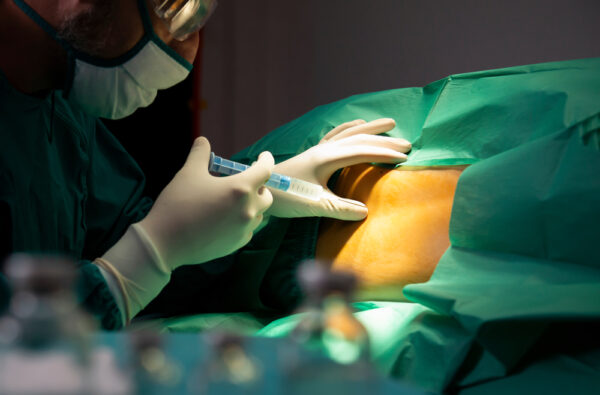With obesity rates affecting over 40% of adults in North America, anesthesiologists are increasingly encountering situations where traditional palpation-based neuraxial techniques fall short. What was once considered a challenging subset of cases has become a significant portion of daily practice. As such, it demands a fundamental shift in approach.
For obese patients, the limitations of landmark-based techniques become starkly apparent. Success rates drop significantly, performance times extend, and patient anxiety increases with each failed attempt. Yet too often, ultrasound guidance remains relegated to a backup plan — something to reach for when traditional methods fail. This reactive approach misses a critical opportunity to provide optimal care from the start.
Accuro offers a different philosophy: making ultrasound-guided precision the primary approach for neuraxial procedures in obese patients. By enhancing visualization before complications occur, AI-assisted imaging allows anesthesiologists to see beyond adipose tissue, measure accurate depths, and place needles with confidence on the first attempt.
Obesity complications in neuraxial anesthesia
The clinical reality is sobering. Studies consistently show that traditional palpation-based neuraxial techniques demonstrate failure rates as high as 90% for first attempts in patients with BMI ≥40, with failure rates progressively increasing as BMI rises above normal ranges. While patients with normal BMI typically experience high success rates with traditional techniques, the contrast becomes stark as obesity increases. These aren’t just statistics — they represent real patients experiencing prolonged procedures, multiple needle insertions, and increased risk of complications.
This disparity highlights an important opportunity. While we can establish new standards of care where imaging and AI-powered guidance become integral to every neuraxial intervention, the immediate need is most pronounced in our growing obese patient population. This isn’t just the next advance for “difficult” cases — it’s the foundation for redefining what’s possible, and what’s expected, from every spinal and epidural procedure. First-pass success is more than a metric — it’s critical for safety; it’s the difference between safe, routine care and the potential for a cascade of suffering, adverse events, and lasting complications.
The physiological complexities are straightforward but significant. Increased subcutaneous adipose tissue obscures traditional anatomical landmarks, making spinous processes nearly impossible to palpate. Too often, it turns routine procedures into educated guesswork. This uncertainty creates the potential for clinical consequences:
- Multiple insertion attempts that increase patient discomfort
- Extended performance times that disrupt workflow
- Higher complication rates that can include inadvertent dural puncture
The operational impact of these problems extends throughout the healthcare system. Extended procedure times can disrupt OR scheduling or delay subsequent cases, as well as increase staffing costs. Perhaps most concerning is the combination of reduced patient satisfaction and increased provider stress, which are detrimental for healthcare organizations (HCOs).

Accuro as a first-line approach
Accuro addresses these complexities directly, using AI-assisted ultrasound to provide enhanced visualization through adipose tissue layers via improved bone-to-tissue contrast and AI-enabled image interpretation. Unlike traditional ultrasound systems that may lack image quality in obese patients, Accuro uses advanced algorithms to enhance bone contrast and automatically identify key neuraxial landmarks, regardless of patient habitus.
Perhaps most critically for obese patients, the system provides accurate depth measurements to the epidural space. When surface landmarks aren’t palpable, this information becomes invaluable for needle selection and insertion planning. Anesthesiologists can determine the exact needle length required and anticipate the depth at which they’ll encounter the ligamentum flavum, eliminating much of the uncertainty that characterizes traditional approaches.
Clinical evidence demonstrates remarkable improvements:
- First-attempt success rates increase from approximately 40% to over 85% depending on the patient population.
- Preprocedural ultrasound reduces the time required for successful needle placement despite the additional imaging step.
- Potential for reduced complication rates compared to palpation-based techniques as a result of decreased needle manipulations, as well as trends toward fewer dural punctures.
The workflow integration proves surprisingly seamless, too. A brief preprocedural scan with Accuro provides crucial information needed for precise needle placement. The time invested in imaging is more than recovered through reduced procedure complexity and fewer failed attempts. It translates to increased confidence when approaching challenging cases — and the mutual satisfaction between patients and providers of consistently successful outcomes.
Training and skill development benefits
Beyond immediate clinical benefits, Accuro offers significant advantages for skill development and training. The visual learning component that traditional palpation-based techniques simply cannot provide creates multiple educational opportunities:
- Enhanced Learning Experience: Clear visualization allows trainees to see exactly what they’re targeting, understand spatial relationships, and receive immediate feedback on needle placement accuracy. It serves to accelerate competency development and builds confidence in managing challenging cases.
- Skill Transfer and Development: Regular use reinforces anatomical understanding and proper technique across all neuraxial procedures. Experience gained with complex obese patients naturally transfers to routine cases, improving overall clinical performance and decision-making.
- Broader Educational Impact: Visual learning reduces the traditional steep learning curve for neuraxial procedures by providing standardized imaging experiences across different patients. These educational benefits extend to institutional strategies for optimizing neuraxial anesthesia programs.
Redefining standard practice
The conversation about neuraxial anesthesia in obese patients needs to shift from managing difficult cases to preventing them. When safe, efficient, and reliable technology is available to ensure success, the real question is: why wouldn’t we make it our first choice?
Accuro is a commitment to providing consistent, high-quality care regardless of patient characteristics. For the growing population of obese patients requiring neuraxial anesthesia, ultrasound guidance should be the standard.
The evidence is clear, the technology is proven, and the patient benefits are substantial. It’s time to make precision neuraxial anesthesia the expectation, not the exception, for all patients who need it.
